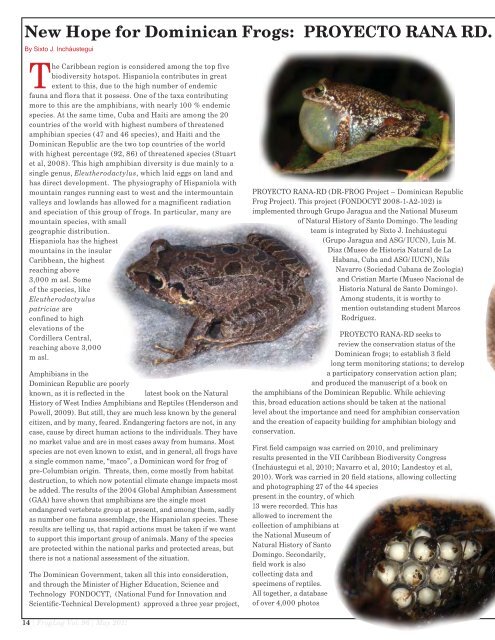download the FrogLog 96 - Amphibian Specialist Group
download the FrogLog 96 - Amphibian Specialist Group
download the FrogLog 96 - Amphibian Specialist Group
Create successful ePaper yourself
Turn your PDF publications into a flip-book with our unique Google optimized e-Paper software.
New Hope for Dominican Frogs: PROYECTO RANA RD.<br />
By Sixto J. Incháustegui<br />
The Caribbean region is considered among <strong>the</strong> top five<br />
biodiversity hotspot. Hispaniola contributes in great<br />
extent to this, due to <strong>the</strong> high number of endemic<br />
fauna and flora that it possess. One of <strong>the</strong> taxa contributing<br />
more to this are <strong>the</strong> amphibians, with nearly 100 % endemic<br />
species. At <strong>the</strong> same time, Cuba and Haiti are among <strong>the</strong> 20<br />
countries of <strong>the</strong> world with highest numbers of threatened<br />
amphibian species (47 and 46 species), and Haiti and <strong>the</strong><br />
Dominican Republic are <strong>the</strong> two top countries of <strong>the</strong> world<br />
with highest percentage (92, 86) of threatened species (Stuart<br />
et al, 2008). This high amphibian diversity is due mainly to a<br />
single genus, Eleu<strong>the</strong>rodactylus, which laid eggs on land and<br />
has direct development. The physiography of Hispaniola with<br />
mountain ranges running east to west and <strong>the</strong> intermountain<br />
valleys and lowlands has allowed for a magnificent radiation<br />
and speciation of this group of frogs. In particular, many are<br />
mountain species, with small<br />
geographic distribution.<br />
Hispaniola has <strong>the</strong> highest<br />
mountains in <strong>the</strong> insular<br />
Caribbean, <strong>the</strong> highest<br />
reaching above<br />
3,000 m asl. Some<br />
of <strong>the</strong> species, like<br />
Eleu<strong>the</strong>rodactyulus<br />
patriciae are<br />
confined to high<br />
elevations of <strong>the</strong><br />
Cordillera Central,<br />
reaching above 3,000<br />
m asl.<br />
<strong>Amphibian</strong>s in <strong>the</strong><br />
Dominican Republic are poorly<br />
known, as it is reflected in <strong>the</strong> latest book on <strong>the</strong> Natural<br />
History of West Indies <strong>Amphibian</strong>s and Reptiles (Henderson and<br />
Powell, 2009). But still, <strong>the</strong>y are much less known by <strong>the</strong> general<br />
citizen, and by many, feared. Endangering factors are not, in any<br />
case, cause by direct human actions to <strong>the</strong> individuals. They have<br />
no market value and are in most cases away from humans. Most<br />
species are not even known to exist, and in general, all frogs have<br />
a single common name, “maco”, a Dominican word for frog of<br />
pre-Columbian origin. Threats, <strong>the</strong>n, come mostly from habitat<br />
destruction, to which now potential climate change impacts most<br />
be added. The results of <strong>the</strong> 2004 Global <strong>Amphibian</strong> Assessment<br />
(GAA) have shown that amphibians are <strong>the</strong> single most<br />
endangered vertebrate group at present, and among <strong>the</strong>m, sadly<br />
as number one fauna assemblage, <strong>the</strong> Hispaniolan species. These<br />
results are telling us, that rapid actions must be taken if we want<br />
to support this important group of animals. Many of <strong>the</strong> species<br />
are protected within <strong>the</strong> national parks and protected areas, but<br />
<strong>the</strong>re is not a national assessment of <strong>the</strong> situation.<br />
The Dominican Government, taken all this into consideration,<br />
and through <strong>the</strong> Minister of Higher Education, Science and<br />
Technology FONDOCYT, (National Fund for Innovation and<br />
Scientific-Technical Development) approved a three year project,<br />
PROYECTO RANA-RD (DR-FROG Project – Dominican Republic<br />
Frog Project). This project (FONDOCYT 2008-1-A2-102) is<br />
implemented through Grupo Jaragua and <strong>the</strong> National Museum<br />
of Natural History of Santo Domingo. The leading<br />
team is integrated by Sixto J. Incháustegui<br />
(Grupo Jaragua and ASG/IUCN), Luis M.<br />
Diaz (Museo de Historia Natural de La<br />
Habana, Cuba and ASG/IUCN), Nils<br />
Navarro (Sociedad Cubana de Zoología)<br />
and Cristian Marte (Museo Nacional de<br />
Historia Natural de Santo Domingo).<br />
Among students, it is worthy to<br />
mention outstanding student Marcos<br />
Rodriguez.<br />
PROYECTO RANA-RD seeks to<br />
review <strong>the</strong> conservation status of <strong>the</strong><br />
Dominican frogs; to establish 3 field<br />
long term monitoring stations; to develop<br />
a participatory conservation action plan;<br />
and produced <strong>the</strong> manuscript of a book on<br />
<strong>the</strong> amphibians of <strong>the</strong> Dominican Republic. While achieving<br />
this, broad education actions should be taken at <strong>the</strong> national<br />
level about <strong>the</strong> importance and need for amphibian conservation<br />
and <strong>the</strong> creation of capacity building for amphibian biology and<br />
conservation.<br />
First field campaign was carried on 2010, and preliminary<br />
results presented in <strong>the</strong> VII Caribbean Biodiversity Congress<br />
(Incháustegui et al, 2010; Navarro et al, 2010; Landestoy et al,<br />
2010). Work was carried in 20 field stations, allowing collecting<br />
and photographing 27 of <strong>the</strong> 44 species<br />
present in <strong>the</strong> country, of which<br />
13 were recorded. This has<br />
allowed to increment <strong>the</strong><br />
collection of amphibians at<br />
<strong>the</strong> National Museum of<br />
Natural History of Santo<br />
Domingo. Secondarily,<br />
field work is also<br />
collecting data and<br />
specimens of reptiles.<br />
All toge<strong>the</strong>r, a database<br />
of over 4,000 photos<br />
14 | <strong>FrogLog</strong> Vol. <strong>96</strong> | May 2011
















